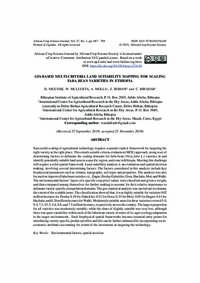GIS-Based multi-criteria land suitability mapping for scaling faba bean varieties in Ethiopia

Authors:
Successful scaling of agricultural technology requires a spatial explicit framework for targeting the right variety at the right place. This entails a multi-criteria evaluation (MCE) approach, using a set of determining factors to delineate the scaling domains for faba bean (Vicia faba L.) varieties in and identify potentially suitable land area in a specific region, and zone in Ethiopia. Meeting this challenge will require a solid spatial framework. Land suitability analysis is an evaluation and spatial decision making, involving several determining factors. The factors considered in this analysis include key biophysical parameters such as climate, topography, soil types and properties. The analysis was also focused on improved faba bean varieties viz., Dagm, Dosha, Gabelcho, Gora, Hachalu, Moti and Walki. The environmental factors’ layers of a specific crop pixel values were classified and given a weight, and then compared among themselves for further ranking to account for their relative importance to delineate variety specific extrapolation domains. The geo-statistical analysis was carried out to estimate the extent of the scalable areas. The classification showed that, it was highly suitable for varieties 0.02 million hectares for Dosha; 0.19 for Gabelcho; 0.11 for Gora; 0.33 for Moti; 0.05 for Dagm; 0.14 for Hachalu; and 0.26 million hectares for Walki. Moderately suitable areas for these varieties covered 5.0, 9.4, 7.2, 15.3, 4.6, 8.8, and 7.5 million hectares, respectively across the country. The largest proportion for all varieties was moderately suitable; while the share of slightly suitable was very low, although there was quite variability within each of the faba bean variety in terms of its agro-ecology adaptation to the target environments. Such biophysical spatial frameworks become essential entry points for introducing variety specific product profiles and this can be further enhanced by incorporating socioeconomic attributes accounting for return of the investment in targeting the technology.
